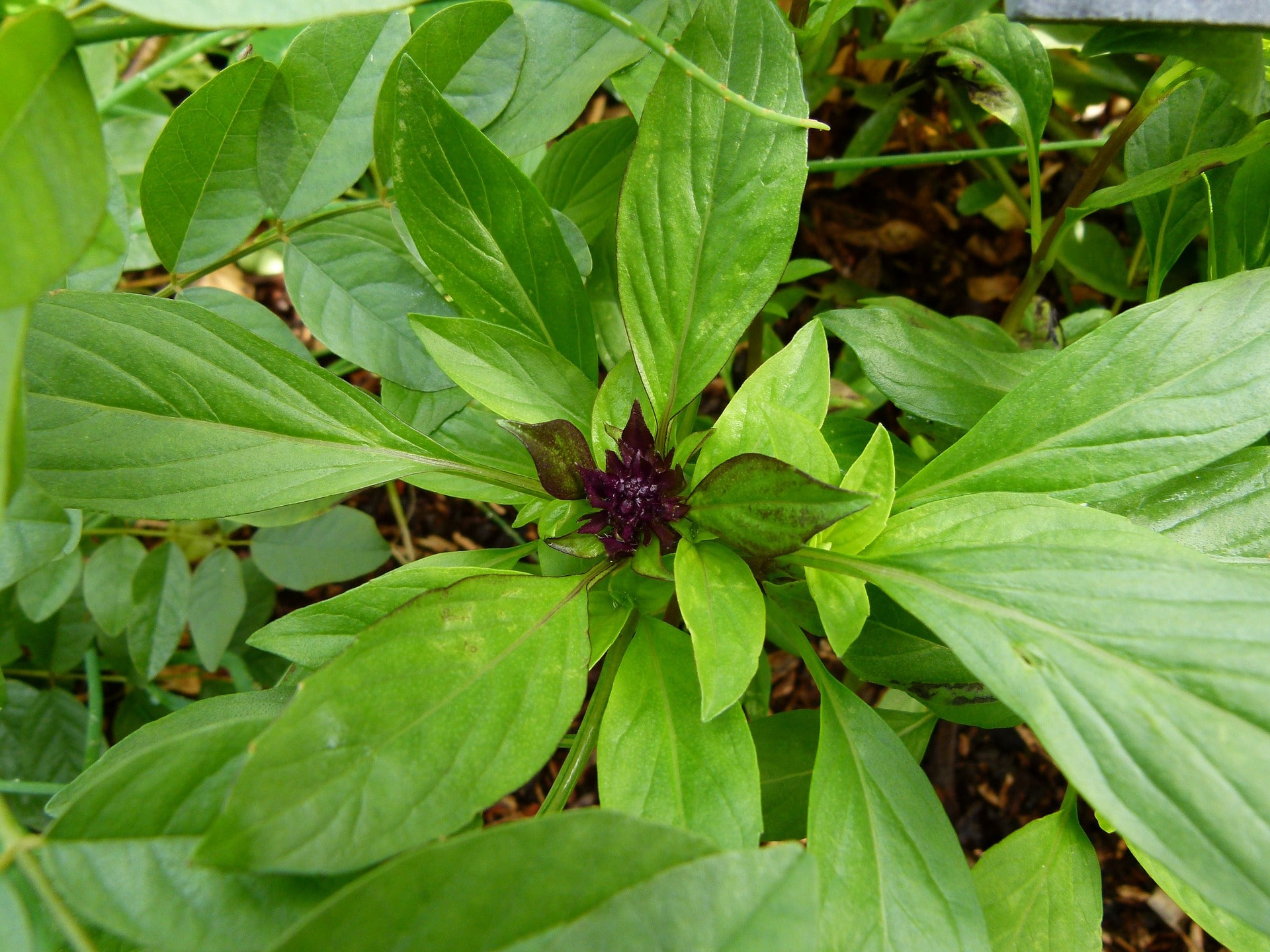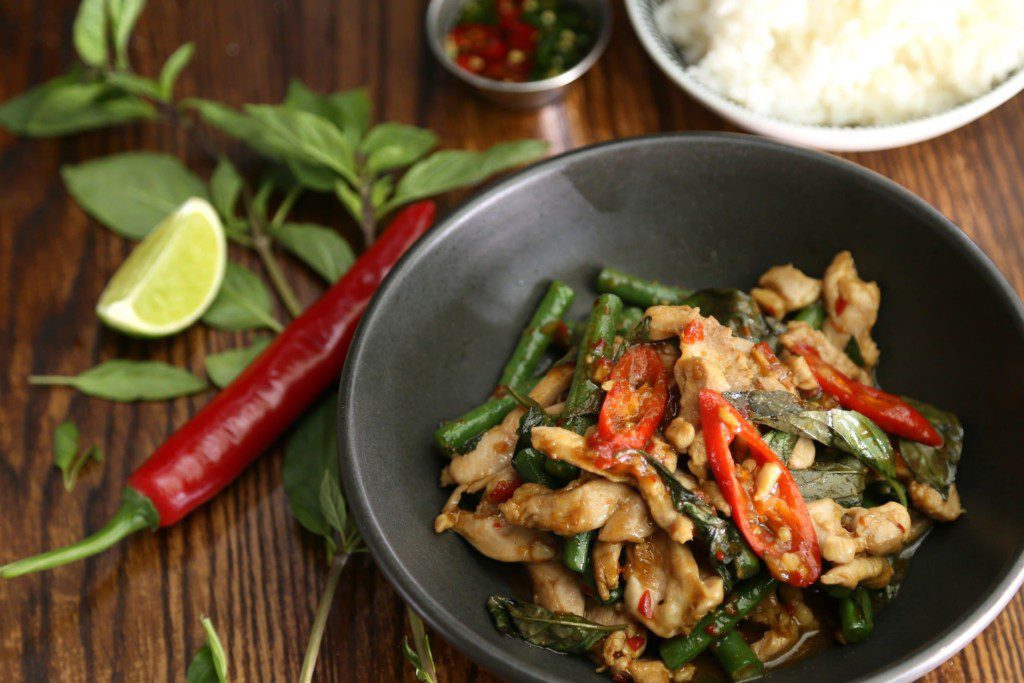Spices and herbs like oregano, rosemary, basil, and parsley are used widely in cooking throughout the world. Basil is a culinary herb that is used widely in European cooking. It belongs to the family of Lamiaceae. It is a tender plant, and the leaves are used in various recipes.
Basil is of various types like sweet basil, Thai basil and many more. Most of these different types of basils can be used as a substitute for each other depending on the type of dish and cuisine.
Let us read more about the different types of basil leaves and the difference between Thai basil and basil.
Table of Contents
Types Of Basil Leaves

Basil is one of the most cultivated herbs that is used in various cuisines. There are different types of basil leaves. The major varieties are mentioned below –
1. Sweet Basil
It is the most common type of basil, which is very popular and is used in salads, pestos and marinades. It has a light green color and a cup-like shape. Sweet basil is also called regular basil or common basil.
2. Italian Basil
It is also called Genovese basil. The leaves of Italian basil are more larger and flat. They have a strong aromatic flavor. This is used commonly to make pesto, marinates and for garnishing too.
3. Thai Basil
The leaves of Thai basil are small, pointed, and dark in color. This fragrant herb is used in many Thai dishes like Thai chicken, sesame noodles, Thai fish, and others. Unlike other basil leaves, the flavor of Thai basil remains intact even when cooked at high temperatures. Because of their unique color, they add a vibrant touch to the dish.
4. Purple or Opal Basil
It does not taste as sweet as other types of basil leaves and has a strong, clove-like flavor. The dark burgundy color is unmissable.
5. Lemon Basil
It has a wonderful citrusy scent that makes it different from the other types of basil leaves. This lemony aroma adds a distinct flavor to the dishes.
6. Holy Basil (Tulsi)
It has a sweet and spicy scent. Eating raw holy basil may taste bitter, so we should cook them before consumption. Holy basil is considered as a sacred plant in Hindu culture and used to make kaadhas and chai. The leaves are also used for medical purposes.
7. Lettuce Basil
Its large wrinkly leaves make it distinctive. You can use it with fresh dishes and different salads.
8. Green Ruffles
It also has slightly curly leaves and looks lovely in a garden. The mild and delicate flavor makes it great for pasta dishes.
Related Reading:
In the battle of basil vs parsley, find out which is better for your kitchen?
Health Benefits of Thai Basil
Thai basil adds an authentic Thai flavor to different cuisines. There are also numerous health benefits of Thai basil leaves. Adding them to your dish not only enriches its flavor, but it also increases the nutrition proportion of the food.
1. Vitamins
Thai basil are packed with Vitamin A. These are great for our eyes and skin health. The leaves have a high level of Vitamin K, which increases bone density and helps in blood clotting.
2. Minerals
Thai basil contains iron, which is an essential mineral and helps to make haemoglobin in the body. It also has a sufficient amount of manganese, potassium, and magnesium.
3. Essential oils
Thai basil has some essential oils that act as antimicrobial components and antioxidants. The essential oils like limonene and eugenol are also great for our health. The essential oils present in Thai basil are inflammatory and fight arthritis. The oils also protect our bodies against certain kinds of bacteria.
4. Improve Metabolism
Basil leaves are also great for our digestive system and enhance the body’s metabolism rate. They reduce the chances of heart disease and fight free radicals. Basil leaves are not only great for our skin; they also fight depression and stress. Thai basil is also great for diabetic patients.
Related Reading:
Amazing reasons to add Basil leaves to your diet.
What Can Be A Good Thai Basil Substitute?

Thai Basil is widely used in different Thai dishes. It gives a pungent flavor to the dish. But if one is unable to get Thai Basil leaves, they can use some other Basil leaves as a Thai Basil Substitute.
1. Holy Basil
Holy basil adds a spicy flavor to Thai dishes. This herb is added to make the food aroma stronger. Its strong flavor and aroma stand out in a dish and provides a certain heat. Holy basil also has numerous health benefits.
2. Italian Basil
Italian basil is used in several Mediterranean dishes. It is one of the most popular herbs in the Western world. From Pesto to Marinara sauces, it can be used almost in everything.
Thai basil and Italian basil belong to the same family, so you can use Italian basil as a Thai Basil Substitute, and the flavor will not change much. Sweet Italian basil has a milder taste, so you have to add a higher amount of Italian basil to get the same flavor. You also need to keep in mind that Italian basil cannot retain its full flavor in the heat, so you must add them at the end of your cooking.
Note: Some also suggest a mix of powdered star anise and fresh basil leaves to achieve a similar flavor.
Thai Basil Substitute – Thai Basil Vs. Sweet Basil (Italian Basil)

Thai basil has numerous health benefits, like all other types of basil. But one of the most asked questions is, what is the difference between Thai Basil and Regular Basil?
Thai basil and regular basil have significant differences in terms of taste, lifespan, appearance, and culinary usages. Regular or sweet basil can be an excellent substitute for Thai basil.
1. Flavor
Sweet basil has a distinctive taste. The taste is a mixture of peppery, anise, and sweetness. On the other hand, Thai basil has a licorice like aroma, and is a bit spicy. Both tastes can be differentiated easily.
2. Appearance
Both of them look very different, mainly their stems, leaves, and flowers. Regular basil has wider, oval-shaped leaves, and Thai basil leaves are straight, narrow, and thin. The stem of Thai basil is purple in color, but regular basil has a smooth green stem.
Sweet basil has small white flowers that grow at the end of their lives, but Thai basil has colorful purple and pink flowers.
3. Lifespan
Regular basil is an annual herb. That means they can only last for one year at the maximum. But Thai basil are perennial plants. They can last for two to three years.
4. Culinary usage
Thai basil and sweet basil add different flavors to your dish. Thai basil goes well with Oriental cuisine. Thai basil chicken, Thai lamb, Thai noodles, all are cooked with Thai basil leaves to add an authentic Thai flavor. Sweet or Regular Basil goes with Mediterranean dishes. These also go well with pizza, Bolognese sauce, pasta, and to make pesto. Its strong taste stands out in these cuisines.
5. Reaction to heat
Both the leaves behave differently to temperature. Thai basil leaves can deal with heat very well, so they are added at the beginning with other spices to release their flavor. But regular basil cannot deal with heat. All its flavor and essential oils get damaged with the heat. This is the reason they are added at the end of cooking.
6. Nutritional content and usage
The seeds of Thai basil can also be used to make cold drinks, and the leaves can be used to make ice creams. If we think of nutritional components, Thai basil has 20% lesser protein and 40% more carbohydrates than sweet basil. But both of them are great for our health.
Related Reading:
Wrapping Up!
So, now we can say that sweet basil or Italian basil can be a great Thai basil substitute. Both of them have similar flavors as they belong to the same family, and they add the same spicy taste to our dishes.
Frequently Asked Questions
Here we have answered a few interesting questions asked by our viewers about basil.
1. Which basil is similar to Thai basil?
Thai basil can be replaced with sweet basil and mint leaves mix to get the grassy and spicy anise-like flavor.
2. Is Thai basil the same as sweet basil?
Thai basil has a spicy note, whereas sweet basil is much on the sweeter side and mildly spicy.
3. Are basil leaves good for health?
Basil leaves have anti-inflammatory properties. Also, it improves digestion and helps in detoxifying the body.


